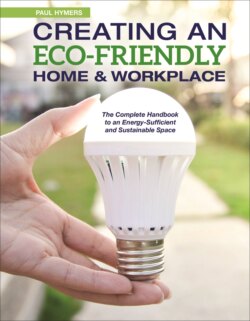Читать книгу Creating an Eco-Friendly Home & Workplace - Paul Hymers - Страница 21
На сайте Литреса книга снята с продажи.
The origins of light emitting diodes (LEDs)
ОглавлениеAn exciting discovery has been made in the early years of this century with those little red diodes that started life in the 1960s in calculator displays. Somebody found a way of making them white, improving their brightness and clustering them into useful lamps. We’ve had coloured light emitting diodes for decades, but white had long been a problem. This was solved by surrounding a blue LED with a phosphorescent dye that glows white when the blue light hits it. Fluorescent lamps employ a very similar trick by producing ultra-violet light in the tube and using a glass coating to turn it white.
The technology is still improving but now with super LEDs. The early cluster bulbs have all but disappeared and have been replaced. Once a 2 watt lamp would have comprised of 20 LEDs clustered together; now it’s just a single super-bright LED. A cluster might comprise 20 LEDs, all neatly packed into circular lamp like a GU10 fitting, commonly used for recessed halogen spot lamps. A light fitting like this would normally have housed a low-voltage or mains halogen lamp of 35 or maybe 50 watts. Bright, white and hot – very hot. A single watt LED can act as an emergency light, giving off 200 lumens or more of light on a stairway or in a hallway. Not only will they do this, but also they will do it without giving off any heat. Before, the millennium halogen spotlights were busy burning 50 watts in recessed ceiling fittings. Many have caused fires setting slight to the structure from the fierce heat they gave off as well. When the LED replacement was first introduced, I held my hand almost touching one and there was not a suspicion of heat coming off it. The room I was in was a loft-conversion bedroom with a low ceiling, and the halogen lamps that had been installed in every other loft conversion and extension I’d visited would have heated a similar room to an uncomfortable level.
A GU10 fitting (left) can house a cluster of tiny LEDs (enlarged, right)
Halogens were designed as spot lamps, and recessing them into ceilings, as so many of us have been doing since the 1990s, meant that they focused bright shafts of light on to the surface below. If that surface was the floor, the ceiling had to have quite a few lamps dotted over it to light the whole room. These lights were once ideal for task lighting where you need bright and directed light, but they rarely got used for that. Instead we peppered our ceilings with them to create ambient light the hard way, and in so doing have wasted a lot of power and created a lot of unwanted heat. In a low ceiling where your head is not far beneath the lights, feeling the scorch of halogen every time you walk beneath one is unpleasant. In one standard sized kitchen, I counted 20 halogen spots in the ceiling, each burning 35 watts – that’s 700 watts at the flick of a switch, and almost enough residual heat to make toast. LEDs run cold, making them perfect for low ceilings.
LED LIFE
LEDs have a life expectancy of around 30,000 hours, which, according to my pocket calculator, means that you could leave them switched on for 24 hours a day, every day for almost four years before they needed to be replaced. Effectively, in normal use, you can forget about having to change them.
CHANGING LOW-VOLTAGE HALOGENS FOR LEDS
Note that 12 volt (extra-low-voltage) LEDs will not tolerate voltage swings created by wire-wound ballasted transformers. Electronic LED-compatible transformers are required if you’re planning to replace your 12 volt halogen lamps with 12 volt LEDs.
LED light with remote transformer
An average sized double bedroom might have a dozen fittings in the ceiling, each covering 1 sq.m of floor with light. Rooms like bedrooms, dining-rooms and landings, where softer light levels are ideal, are most suited to them. Lounges, kitchens and reception rooms tend to need brighter ambient lights or task lighting, so I would avoid them in such situations.
